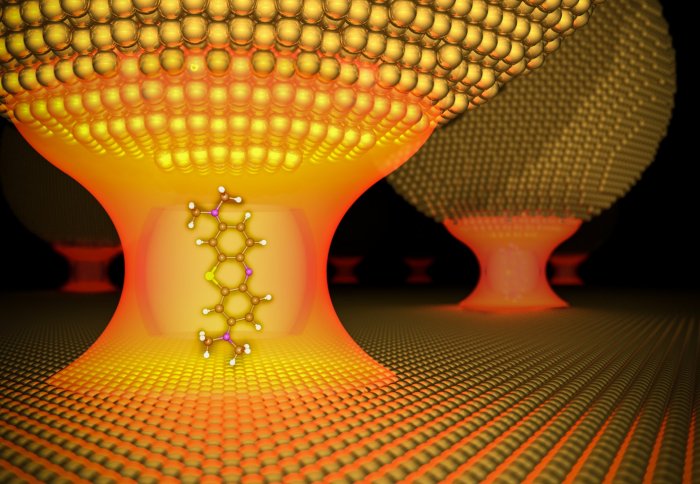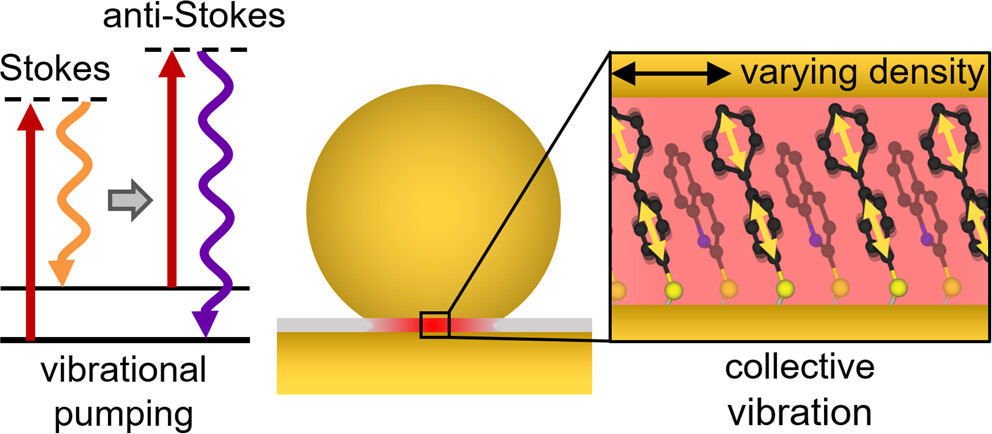Optomechanical control of molecular motion
At first glance, molecules seem too small and too chaotic to be controlled with light. Their atoms jiggle ceaselessly, driven by thermal energy, and their vibrations—tiny oscillations of chemical bonds—usually remain hidden in the background. But recent work has shown that we can, in fact, use light not only to measure these vibrations but also to amplify and coordinate them. This research 1 demonstrates how tightly confined light in nanoscale metal cavities can pump molecular vibrations in a way that resembles the optomechanical principles, a field traditionally reserved for much larger systems like mirrors and membranes.
A tiny gap

The key playground for this study is the nanoparticle-on-mirror (NPoM) cavity. Imagine placing a gold nanoparticle just a nanometer above a flat gold film, separated only by a single layer of organic molecules. This tiny gap acts as a resonator for light, trapping electromagnetic fields so intensely that molecules sitting in the gap experience an amplification of optical interactions by many orders of magnitude. Such structures are already well-known for enabling surface-enhanced Raman scattering (SERS), which can boost otherwise weak vibrational signals enough to detect single molecules. But here the focus is not only on detecting vibrations—it is on actively driving them.
Stokes and anti-Stokes
To understand what the researchers mean by “driving,” it helps to recall how Raman scattering works. When light interacts with a molecule, most photons scatter elastically, leaving with the same energy they arrived with. But a small fraction exchange energy with a vibrational mode of the molecule. If a photon loses energy, the molecule gains a vibrational quantum, and we call this Stokes scattering. If a photon gains energy by taking it from a vibrating molecule, we call it anti-Stokes scattering. Normally, at room temperature, the probability of anti-Stokes scattering is low because vibrations are sparsely populated. But if Stokes scattering itself begins to build up a vibrational population—essentially “pumping” the vibration—the anti-Stokes signal grows dramatically.

This is exactly what the researchers observed. By shining pulsed laser light into hundreds of NPoM cavities containing biphenyl-4-thiol molecules, they monitored both the Stokes and anti-Stokes Raman signals. For certain high-frequency vibrations, the anti-Stokes intensity did not simply scale linearly with laser power as one would expect from heating. Instead, it showed quadratic growth, clear evidence that the molecules’ vibrations were being actively pumped by the light field. The molecules were, in a sense, being shaken into coherent motion by the cavity-enhanced scattering.
Molecules are not isolated actors
But the story does not end with individual molecules. The researchers went further, probing whether molecules vibrate independently or collectively when packed together at nanometer distances. To test this, they diluted their molecular layer with a second species that has different vibrational fingerprints, thereby controlling the spacing between active biphenyl-4-thiol molecules. They found that as the molecules were spread farther apart, the vibrational pumping weakened. This indicates that the molecules inside the cavity are not isolated actors; rather, their vibrations couple through the plasmonic field of the cavity, forming collective vibrational modes. Such modes behave more like the synchronized oscillations of an ensemble than the random jiggle of individual bonds.
Optomechanical modelling
The researchers supported these experiments with detailed optomechanical modelling. Traditionally, cavity optomechanics considers how a mechanical oscillator—say, a mirror on a spring—couples to light confined in a resonant cavity. Here, the role of the mechanical oscillator is played by the molecules’ vibrational modes, and the cavity is the plasmonic gap between nanoparticle and mirror. Unlike macroscopic optomechanical systems, which often need cryogenic cooling to reach the quantum ground state, many molecular vibrations already start “cold” relative to their vibrational energy scale at room temperature. This makes them especially attractive for exploring optomechanical effects without elaborate setups. The models reproduced the key features of the experiments only when collective vibrational coupling was included, emphasizing that these interactions cannot be ignored.
Bond-selctive chemistry and phonon lasers
One of the striking consequences of collective coupling is that it lowers the laser intensity required to observe vibrational pumping. In other words, molecules working together vibrate more easily than they do alone. This finding has intriguing implications. If we can reliably excite specific vibrations, we might influence chemical reactions selectively by targeting certain bonds—a vision sometimes referred to as bond-selective chemistry. Furthermore, the coherent nature of collective vibrations hints at possibilities for phonon lasing, where vibrational quanta (phonons) are amplified much like photons in an optical laser, and for exploring instabilities where vibrations grow uncontrollably under strong illumination.
A word of caution…
Beyond the immediate excitement, this work also raises caution for how we interpret Raman experiments. Traditionally, researchers estimate vibrational populations from the ratio of anti-Stokes to Stokes signals, treating molecules as independent. But this study shows that in strongly coupled nanocavities, that ratio reflects collective populations, which behave differently. Thus, careful theoretical modelling is required to extract meaningful physical quantities.
…but the vision is ambitious
In summary, this research bridges the gap between nanophotonics, molecular spectroscopy, and optomechanics. By confining light in plasmonic nanocavities, the team has shown that it is possible to pump and manipulate molecular vibrations at room temperature, and that these vibrations can act collectively when molecules are closely packed. It opens the door to controlling matter at its most fundamental level—bond vibrations—not by brute force heating, but by the subtle interplay of light and mechanics on the nanoscale. The vision is ambitious: chemistry guided not just by reagents and temperature, but by the quantum optomechanical control of molecular motion itself.
Author: César Tomé López is a science writer and the editor of Mapping Ignorance
Disclaimer: Parts of this article may have been copied verbatim or almost verbatim from the referenced research paper/s.
References
- Lukas A. Jakob, Adrián Juan-Delgado, Niclas S. Mueller, Shu Hu, Rakesh Arul, Roberto A. Boto, Ruben Esteban, Javier Aizpurua, and Jeremy J. Baumberg (2025) Optomechanical Pumping of Collective Molecular Vibrations in Plasmonic Nanocavities ACS Nano doi: 10.1021/acsnano.4c16535 ↩